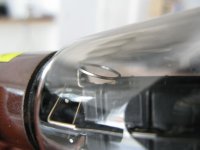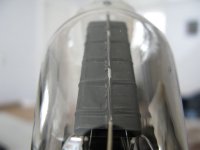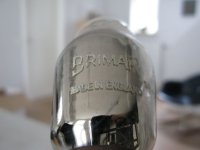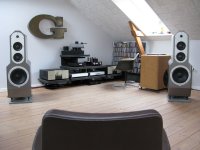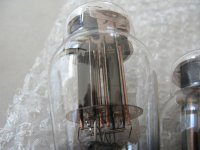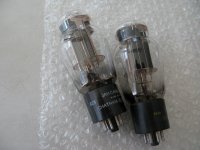Hugh, but what is the tube called. Is it Italian. Where can I get a dozen to last the like time of my Tram2. I want to get in before the price sky rockets.
Peter
Luigi tells me he was a radio operator in WWII and sent a picture with his special rectifiers in the top right.
Kind of hard to say as the pic isn't to good, but if I were to guess, I would say they were 872a Mercury Vapor Rectifiers.
Big radio setups back then often used Mercury Vapor Rectifiers, and judging by the size of them, I believe they are 872a tubes, or maybe even 575a tubes.
I've always fancied having something using Mercury Rectifiers - VT83s, perhaps.
Just a little bit of madness. No technical reason.
Graham
Mercury exposure causes more then a "little bit of madness".
As Im quite mad enough Ive decided to stick with with Morten's Philip and Brimar
rectifier recommendations. This has the bonus of reducing my personal SNR in this thread
Ok... Finally did enough comparisons between the Philips and Brimar rectifiers to lock in on the differences. I think it's hard to compare rectifiers because it's not a simple A/B test. The preamp/amps has to be shut down, new rectifier in, power up, wait for everything to settle in again... And by this time it can be tough to remember small differences (for me at least). But I have gone back and forth enough to be quite certain of the differences now. Mind you, the Brimar is mentioned as ''one of the great ones'' and in the same league as the WE 274B and a few others, so how does the Philips compare..!? This is what I hear in my system (system picture for reference).
The differences are really at the ends of the frequency spectrum, where the Philips has it's focus in the bass and midrange, the Brimar has it's focus in the midrange and treble.
The Philips has the fuller, more dynamic and powerful sound. Compared to the Brimar it's fuller in the bass and lower midrange and the treble is sweeter and a bit more recessed. This gives the impression of ''meat on the bones'' and a sonic landscape that has an excellent foundation, grounding and punch. But the treble is a bit mellow and not as open as the Brimar.
Swapping in the Brimar the impression at first can be a bit like; where did the bass go..!? Getting used to the Brimar, there is not a lack of bass, but the bass is more nimble and not with the power of the Philips. This gives a slightly leaner sound, but also a sound that appears to have a bit more transparency and more precision. The treble of the Brimar is truly wonderful and noticeably more open and resolved compared to the Philips.
If one think the Philips is neutral, then the Brimar will sound a bit too bright. If one think the Brimar is neutral, then the Philips will sound a bit too dull... So in a system, that is a bit on the lean side: Philips and in a system that is a bit on the full side: Brimar. I think they are at the same sonic level, one is not better than the other, it's a matter of system matching. I think the Brimar was lightly used before I got it where as the Philips was clearly NOS (unopened original box), so maybe the Philips needs more hours to fully open up in the treble range, I have only around 50 hours on it now. I will continue to use the Philips for now to put some hours on it, if it opens up more in the treble range and get's closer to the treble of the Brimar then I will say the Philips (in my system) is the better choice...
Here are some pics of the Brimar if you want to look for one. They are made in the 1950's, not that expensive but not that easy to find. This one has the logo on the glass bottle, some has it on the (brown) base. The internal structure is with black ribbed anodes and with dual halo getters at the bottom.
The differences are really at the ends of the frequency spectrum, where the Philips has it's focus in the bass and midrange, the Brimar has it's focus in the midrange and treble.
The Philips has the fuller, more dynamic and powerful sound. Compared to the Brimar it's fuller in the bass and lower midrange and the treble is sweeter and a bit more recessed. This gives the impression of ''meat on the bones'' and a sonic landscape that has an excellent foundation, grounding and punch. But the treble is a bit mellow and not as open as the Brimar.
Swapping in the Brimar the impression at first can be a bit like; where did the bass go..!? Getting used to the Brimar, there is not a lack of bass, but the bass is more nimble and not with the power of the Philips. This gives a slightly leaner sound, but also a sound that appears to have a bit more transparency and more precision. The treble of the Brimar is truly wonderful and noticeably more open and resolved compared to the Philips.
If one think the Philips is neutral, then the Brimar will sound a bit too bright. If one think the Brimar is neutral, then the Philips will sound a bit too dull... So in a system, that is a bit on the lean side: Philips and in a system that is a bit on the full side: Brimar. I think they are at the same sonic level, one is not better than the other, it's a matter of system matching. I think the Brimar was lightly used before I got it where as the Philips was clearly NOS (unopened original box), so maybe the Philips needs more hours to fully open up in the treble range, I have only around 50 hours on it now. I will continue to use the Philips for now to put some hours on it, if it opens up more in the treble range and get's closer to the treble of the Brimar then I will say the Philips (in my system) is the better choice...
Here are some pics of the Brimar if you want to look for one. They are made in the 1950's, not that expensive but not that easy to find. This one has the logo on the glass bottle, some has it on the (brown) base. The internal structure is with black ribbed anodes and with dual halo getters at the bottom.
Attachments
Last edited:
Hello Morten
it will be at bit difficult to tell if the Phillips tube are better now,than before...i have get some new opamp (ad8620) in my groundsound filter..so i can not tell if i heard the tube or the opamp
one thing is for sure..it is more quiet than the Russian tube i use before,,,for the first time i can not hear noise where i normally sit---but still ,love the sound from the Phillips tube
best Bjarne
it will be at bit difficult to tell if the Phillips tube are better now,than before...i have get some new opamp (ad8620) in my groundsound filter..so i can not tell if i heard the tube or the opamp
one thing is for sure..it is more quiet than the Russian tube i use before,,,for the first time i can not hear noise where i normally sit---but still ,love the sound from the Phillips tube
best Bjarne
Good to hear that you like the Philips, it (and the Brimar) is a very clear step above the ''standard'' rectifiers  So you still had noise, until the Philips..!? Was this hum or a different kind of noise?
So you still had noise, until the Philips..!? Was this hum or a different kind of noise?
Strange that you have had this many noise issues..! It can -maybe- be down to the wiring of your DHT regulators. They need to be really short, and it's good to have the wires run close to grounded parts like heatsinks or equal. Here at my place my Tram II is now very quiet. It's not until I have the ear around half a meter from the speaker that I can hear a faint hum. Going to the fixed resistor set-up on the CCS modules also reduced noise - and of course there is now zero drift... I think that the Tram II is finally a ''finished product'' and not a collection of nice of parts, not fully developed. I'm looking forward to compare it to friends high end preamps soon, and I hope it will do well
Strange that you have had this many noise issues..! It can -maybe- be down to the wiring of your DHT regulators. They need to be really short, and it's good to have the wires run close to grounded parts like heatsinks or equal. Here at my place my Tram II is now very quiet. It's not until I have the ear around half a meter from the speaker that I can hear a faint hum. Going to the fixed resistor set-up on the CCS modules also reduced noise - and of course there is now zero drift... I think that the Tram II is finally a ''finished product'' and not a collection of nice of parts, not fully developed. I'm looking forward to compare it to friends high end preamps soon, and I hope it will do well
Last edited:
The noise is a kind of hiss..not hum..with the Phillips it is much lower..no problem
just find out that there is less noise ,when i use my player without dac--not much but i can hear it (could be the dac gives more information)
but all in all no problem with noise
best Bjarne
just find out that there is less noise ,when i use my player without dac--not much but i can hear it (could be the dac gives more information)
but all in all no problem with noise
best Bjarne
To clearly identify if the noise is from the preamp or from a component like your dac, you can connect one of the inputs on the preamp to ground and then listen to the noise on that input... If the noise is the same, then it's from the preamp. If the noise is lower, then it indicates that the noise you hear is from earlier in the chain... And good that it's no longer a problem like it was earlier.
Time for some Mu tube rolling  I have used the Russian version of the 6AS7 (a bit warm sounding), but most of the time I have used the Cunningham 6AS7 (a bit leaner than the Russian and more open sounding).
I have used the Russian version of the 6AS7 (a bit warm sounding), but most of the time I have used the Cunningham 6AS7 (a bit leaner than the Russian and more open sounding).
I have been trying to get a idea about what is considered the good sounding 6AS7, and as usual the one that are considered ''best'' are the very rare and expensive ones. I can't help but think, that because these nos tubes are considered so good is -partly- because they are so exotic... When reading comments on the Internet I noticed that many consider Chatham Electronics 6AS7 amongst the good sounding ones, and they are reasonably prices. Apparently Chatham Electronics was acquired by Tung-Sol, so later on these tubes was named; Chatham / Tung-Sol.
I have bought a nice pair of Chatham Electronics 6AS7 and it will be interesting to hear, if they make any difference in sound. Beautiful tubes with their copper posts..!!!
I have been trying to get a idea about what is considered the good sounding 6AS7, and as usual the one that are considered ''best'' are the very rare and expensive ones. I can't help but think, that because these nos tubes are considered so good is -partly- because they are so exotic... When reading comments on the Internet I noticed that many consider Chatham Electronics 6AS7 amongst the good sounding ones, and they are reasonably prices. Apparently Chatham Electronics was acquired by Tung-Sol, so later on these tubes was named; Chatham / Tung-Sol.
I have bought a nice pair of Chatham Electronics 6AS7 and it will be interesting to hear, if they make any difference in sound. Beautiful tubes with their copper posts..!!!
Attachments
The 2399 can sometimes be substituted in a 6AS7 circuit. Here are a few other tubes that might be considered.
6080 - low gain @ 2
7236 - medium gain - great bass, fast and dynamic.
5998A - medium gain in straight bottle. Plate construction like 6AS7.
5998 - medium gain at 5, full-bodied sound, same current load as 6AS7
421A - same as 5998 but with matched plates/sections
6AS7G - low gain, the standard tube for most, plentiful
6AS7GA - low gain, like the standard 6AS7G in striaght bottle
6520 - premium 6SA7G, sometimes with 5998 plates
6H13 - russian 6AS7G equivalent. nothing magical with these
ECC230 - european 6AS7G equivalent. haven't seen one in person
6528 - equiv to 5998 but very high gain at 9, twice the current load. Make sure you amp can handle it
6336 - like 6528 but low gain at 2, still twice current load. Make sure you amp can handle it
6080 - low gain @ 2
7236 - medium gain - great bass, fast and dynamic.
5998A - medium gain in straight bottle. Plate construction like 6AS7.
5998 - medium gain at 5, full-bodied sound, same current load as 6AS7
421A - same as 5998 but with matched plates/sections
6AS7G - low gain, the standard tube for most, plentiful
6AS7GA - low gain, like the standard 6AS7G in striaght bottle
6520 - premium 6SA7G, sometimes with 5998 plates
6H13 - russian 6AS7G equivalent. nothing magical with these
ECC230 - european 6AS7G equivalent. haven't seen one in person
6528 - equiv to 5998 but very high gain at 9, twice the current load. Make sure you amp can handle it
6336 - like 6528 but low gain at 2, still twice current load. Make sure you amp can handle it
Yes, there's lots of choice for the Tram2 "mu" tube.
Just be aware that the sonic comments in the list above like "great bass" probably refer to the tubes used in OTL headamps ,where its low output impedance allows direct output. So the sonic comments might be meaningless to the Tram2 application.
Ive got a heap of 6AS7 tubes from my own headamp. In the Tram2 I used a black plated RCA 6AS7G with very good results. This is a plentiful and inexpensive tube. As Morten noted its quite possible such a cheap mu tube might out perform the rare and pricey NOS offerings.
If anyone can borrow and listen to the expensive NOS mu tubes do let us know if the sound changed for the better or worse?
Just be aware that the sonic comments in the list above like "great bass" probably refer to the tubes used in OTL headamps ,where its low output impedance allows direct output. So the sonic comments might be meaningless to the Tram2 application.
Ive got a heap of 6AS7 tubes from my own headamp. In the Tram2 I used a black plated RCA 6AS7G with very good results. This is a plentiful and inexpensive tube. As Morten noted its quite possible such a cheap mu tube might out perform the rare and pricey NOS offerings.
If anyone can borrow and listen to the expensive NOS mu tubes do let us know if the sound changed for the better or worse?
Yes they were used in OTL headamps.
and could have a different affect in the Tram circuit.
I had the info in my computer, I did not do the testing myself, just wanted to let other know that there are a few other tubes to roll if one wishes.
It's nice to have options, but it can be a curse as well.
and could have a different affect in the Tram circuit.
I had the info in my computer, I did not do the testing myself, just wanted to let other know that there are a few other tubes to roll if one wishes.
It's nice to have options, but it can be a curse as well.
Does anyone know if the Tram2 Mu tube needs to have a 6AS7G specific rated doubling amplification factor for compatibility?

6AS7G Mu = 2, Gm = 7000, Rplate = 280 ohms
6080 Mu = 2, Gm = 6500-7000, Rplate = 280-300 ohms
6520 Mu = 2 (1.9-2.4) Gm 6400 - 7600
6H13C Mu=2.4 ?????
5998 Mu = 5.4 Gm = 15500, Rplate = 350 ohms,
7236 Mu = 4.8 Gm = 12500, Rplate = 350 ohmshttp://www.tubes.ru/techinfo/HiFiAudio/6n13c.html

6AS7G Mu = 2, Gm = 7000, Rplate = 280 ohms
6080 Mu = 2, Gm = 6500-7000, Rplate = 280-300 ohms
6520 Mu = 2 (1.9-2.4) Gm 6400 - 7600
6H13C Mu=2.4 ?????
5998 Mu = 5.4 Gm = 15500, Rplate = 350 ohms,
7236 Mu = 4.8 Gm = 12500, Rplate = 350 ohmshttp://www.tubes.ru/techinfo/HiFiAudio/6n13c.html
Last edited:
Yes they were used in OTL headamps.
and could have a different affect in the Tram circuit.
Yes, the application is totally different in the Tram where the 6AS7 is in the final stage of the power supply doing voltage/current regulation of the B+ voltage before the triode. In those headamps the 6AS7 is in the signal path. This is also why I don't just rush out and buy one of those rare and expensive tubes mentioned as the holy grail when used in headamps. I have the Chatham up and running now, it should (for headamp use) be on the lean and detailed side of the fence, whereas the Cunningham I normally use should be fuller sounding - in headamps. If I hear the same pattern in the Tram, then maybe the experiences from headamp use can be transferred...
the 6AS7 is in the final stage of the power supply doing voltage/current regulation of the B+ voltage before the triode.
My reading of the circuit is somewhat different. I believe that if the circuit is traced out, 2a3 - modified CCS and 6AS7 together form what Thorsten refers to elsewhere as a Super mu follower circuit.
if you look at Richard sears circuit: 845 SE Triode the one with the choke is similar to what we have in the Tram2, but with the high impedance of the choke replaced by the modified CCS, as discussed by Thorsten here: The Super Mu Stage (No Bovine Jokes please).... - Thorsten - Bottlehead Forum
Some background on the mu follower can be found here: Mu Stage Philosophy © 1993 Alan Kimmel
This suggests to me that the 6AS7 "mu tube" is just that, part of the modified mu follower stage, and not part of the power supply. Its role is to help isolate the audio stage from the power supply, but I would suggest that it is likely to remain audible, particularly there are so many reports that the rectifier tube remains audible.
In other uses I prefer 6080 over 6AS7, but unfortunately they are tricky to use in the Tram2 due to the size of the base on most 6080s.
best of luck
Simon
- Status
- This old topic is closed. If you want to reopen this topic, contact a moderator using the "Report Post" button.
- Home
- DIY HiFi Supply
- DHT OTL Linestage - Tram 2
